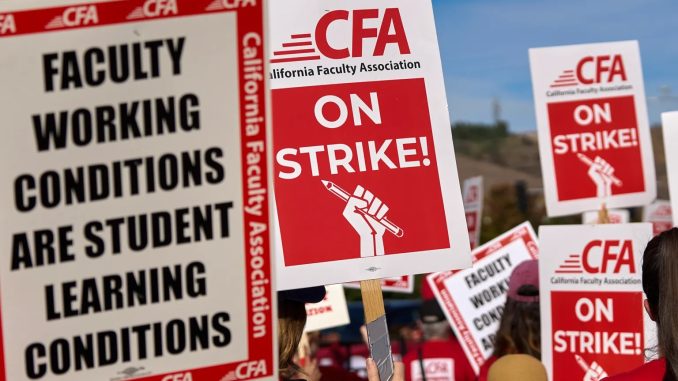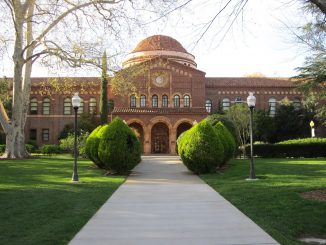
By by Mikhail Zinshteyn (for Cal Matters)
This story was produced by CalMatters, an independent public journalism venture covering California state politics and government. For more info, visit calmatters.org.
After more than half a year of failed negotiations to increase their pay by 12 percent and expand other benefits, the faculty of the California State University today began a historic strike at all 23 campuses.
The planned one-week work stoppage is the first time the California Faculty Association has walked off the job at every campus since the union was founded in 1983. It’s part of an escalation of tactics by the faculty group, which staged one-day strikes at four campuses last month and vowed then to up the ante if their demands weren’t met.
“It’s a constant struggle to make ends meet,” said Dirk Horn, a full-time political science lecturer at Cal State Bakersfield who augments his salary of just under $63,000 by teaching at nearby community college locations, other schools and picking up gigwork as an Uber driver.
Some days, his teaching shifts require nearly 80 miles of driving across three campuses.
Receiving the raises the union is seeking would let him work less—and earn more.
“I wouldn’t have to seek those outside income sources because I’d be able to pay my bills, essentially, with my one full-time job,” Horn said.
For Cal State, the strike represents a likely loss of learning for many of its nearly 460,000 students at the nation’s largest public four-year university system. The systemwide strike coincides with the first day of spring term at most campuses, and while workers have the right to strike, they also have the right to buck the union.
“Faculty may choose to teach their courses as scheduled,” said Leora Freedman, who heads human resources at Cal State, at a Friday press conference.
All campuses will remain open, said Mildred Garcia, system chancellor, at a press conference Friday. So far there are no plans to extend the length of the spring term.
About 25 picketers showed up at Cal State Los Angeles on a rain-soaked morning, their ranks gradually increasing as the droplets dissipated.
“Hey hey, beep beep, the CSU is mighty cheap,” the faculty chanted as they intermittently blocked traffic on the main road at the campus.
Honoring the union’s demands would lead to layoffs and cuts to student services, Freedman said, echoing past Cal State statements. The faculty union maintains the university can afford it.
A striking worker teaches no classes, avoids meeting with students during office hours and answers no work-related emails. Working partially could jeopardize a faculty member’s right to strike, the union warns.
The faculty union represents 29,000 professors, lecturers, librarians, sports coaches and mental health professionals. Negotiations between the labor group and Cal State management to ward off this week’s strike broke down two weeks ago, further entrenching both camps. They haven’t bargained since, said Kevin Wehr, bargaining team chair for the union and a professor at Sacramento State.
The smaller Teamsters Local 2010, a labor group of 1,100 skilled maintenance workers, agreed to a contract with Cal State negotiators Friday, canceling their planned strike this week.
Salary and benefits impasse
The faculty union and Cal State officials are far apart on pay. The university offered to provide a 5 percent raise, not the 12 percent the union is seeking for this year as a way to combat recent spikes in inflation that diminished the buying power of faculty salaries. Cal State’s 5 percent offer is consistent with the deals it finalized with other unions last year to avoid an even larger walkout of all the roughly 60,000 unionized workers. Cal State negotiators have also proposed to extend parental leave for faculty from six weeks to eight weeks, still less than the full semester that the union wants.

An independent fact-finder affiliated with the state recommended that Cal State provide the faculty union a 7 percent raise—an amount the faculty union said is too low. If there’s to be a compromise, it’ll land somewhere between 7 percent and 12 percent.
University negotiators have offered the faculty 15 percent raises over three years, contingent on growing state funding—no sure thing as California eyes multi-billion-dollar deficits. The faculty refuses to accept any raises that are conditional.
Lecturers and professors earn between $64,000 and $122,000 on average. Wages for the lowest-paid faculty have risen about 20 percent on average since 2007, but grew by about 40 percent for campus presidents, whose average salaries are now more than $400,000. The new system chancellor, Mildred Garcia, earns close to $1 million from pay as well as car and housing allowances.
English lecturer Laura Quinn is basically working two full-time teaching jobs to earn $86,000 annually. At Cal State San Bernardino and the private University of Redlands combined, she taught 27 units in the fall semester. Typically, 15 units is considered full-time.
“The majority of lecturers that I know are working on two or three campuses trying to cobble together a living wage, and that’s not good,” she said.
One major impediment to providing the faculty union a higher general raise? The university secured labor deals with other unions that include reopening salary negotiations if any other union received more than a 5 percent raise.
Other disputes aren’t about pay. For example, the union wants lactation rooms with door locks for new parents. Cal State labor negotiators say the university already complies with the labor codes for pumping breastmilk. The faculty union also seeks more mental health counselors, among other demands.
Cal State negotiators said they would agree to 13 of the 15 recommendations the fact finder provided in December—but not on salary.
Docked pay
Cal State vows to dock the pay of workers who strike. “It is a misuse of taxpayer dollars for the CSU to compensate any employee who withholds work,” wrote Amy Bentley-Smith, a Cal State spokesperson.
Faculty who strike for a week can expect pay reductions of about 3 percent, she added.
Union leaders are urging all members to walk the picket lines and avoid work, even the lowest-paid workers who earn the equivalent of $54,000 annually.
Nearly two-thirds of faculty are in the bottom half of the four pay ranges, a union spokesperson told CalMatters. And a majority of those workers earn the lowest salaries in those ranges. In 2022, the lowest levels were $54,000 and $65,000 for the two ranges. The union is demanding that Cal State raise those minimum salaries by $10,000 and $5,000, respectively.
All campuses except San Francisco State, where spring term starts next week, are encouraging students to report their instructors if they canceled classes this week, according to a CalMatters review of campus websites. “If a class or service is cancelled, you are welcome to share that information with us here so that we can best assure continuity and fulfillment of instruction,” Cal State Northridge wrote to students, using language common across all the other campuses that are asking students for that information.
Students in solidarity with faculty are pushing back. On the social media platform Reddit, some students across multiple campuses proposed flooding those reporting forms with fake professor names or complaints about administrators instead.
“It just feels wrong that they’re trying to drag us students into it and have us turn on our professors,” said Jasmine Puente, a Cal State Long Beach student. “A lot of students just don’t want to do that. We want to stand by our professors and we don’t want to be a part of taking them down.”
As an aspiring teacher coming from a family of educators—including her mom who teaches elementary school and is president of her local union—Puente grew up supporting educators and unions. She recently graduated with a history degree from Cal State Long Beach and is currently working on her single-subject credential.
Meanwhile, the faculty union said that Cal State leaders are asking all faculty to self-report if they didn’t work this week. The union told its members that they’re not obligated to inform their campuses about their intent to strike, but should answer truthfully in the event their managers ask afterward if they walked off the job. The faculty union message added that while Cal State is “legally able to dock the pay of striking faculty, keep in mind that we will recover this and much more when we win a fair contract.”

The union cannot coerce members to strike nor can faculty require students to take part in labor action in exchange for a grade, various campus FAQs say. Similarly, campus managers are barred by law from punishing workers who picket.
Budget disputes
Throughout the negotiations, Cal State said it cannot afford the faculty union’s demands. The system last May revealed that it spends $1.5 billion less than needed to adequately educate its students. That finding prompted Cal State’s board of trustees last September to usher in consecutively escalating tuition hikes starting this fall—increases totaling 34 percent over five years. However, most undergraduates don’t pay any tuition because they receive enough state and system financial aid. The faculty union opposed those hikes.
“The union stood by us and tried to fight against the tuition hikes,” Puente, the Long Beach State student, said. “I think that we as students can stand by them too.”
The labor group’s leaders hired an accounting professor last fall who concluded that Cal State reroutes more than enough annual surpluses toward its own reserves that could instead go toward student services and faculty pay. The annual surpluses are so high that the university wouldn’t need to touch the money it’s already stored in savings to pay the faculty union’s salary demands, the accounting professor said. University officials refute that contention, saying they must build a financial cushion to withstand economic turmoil and presently fall well short of their own savings goals.
Despite new revenue from the tuition hikes and extra dollars Gov. Gavin Newsom promised, system finance analysts said last year that Cal State would still run deficits under a scenario in which all university workers receive 5 percent raises.
A wider set of contract items will be up for negotiation this June. The current labor acrimony risks spilling into those quickly approaching bargaining sessions.




Be the first to comment